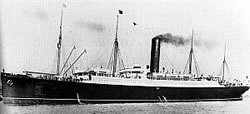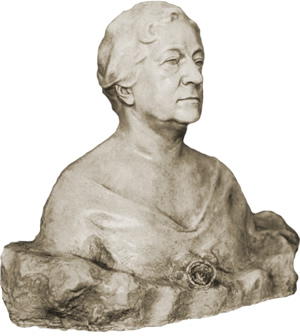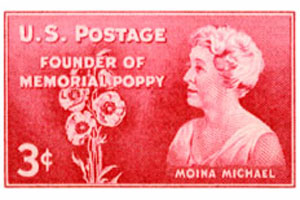Moina Belle Michael Biography (1869-1944)

|
Moina Belle Michael was an American teacher who had the idea to create an emblem of Remembrance using the red Flanders poppy. At the age of 49, with a career in teaching for over 30 years already behind her, she had this inspirational idea in November 1918. She decided to dedicate her life to campaign to have this emblem recognized by governments, veteran agencies and the public.
She continued with this project for the next 26 years until her death in 1944 and became affectionately known as “the Poppy Lady”.
Ancestors and Parents
The Michael Family in Georgia
The Michael family name arrived in America from Bretagne (Brittany) as one of the immigrant Hugenot families from France. The first representative of the Michael family in Georgia, Valentine Michael, is believed to have arrived in 1791. He was with his wife Marie Jean (née Motier) and son Guillahume (William) who had been born in France. There were two other children Gabriel and Michele (believed to be born in America). The family settled in Walton County where Valentine became a farmer.
Valentine's great-great-grandson John Marion Michael would become father to Moina in 1869.
Paternal Grandparents: William Michael and Laney Cannon
William Michael, the great-grandson of Valentine, married Laney Cannon. William was the then owner of the cotton plantation which had been passed down through the Michael family. William and Laney had two sons, William Lafayette and John Marion. John was born on 22nd October 1843. He would become Moina's father.
John's middle name Marion was inherited from the Marion family which Valentine Michael had married into; Valentine's mother-in-law was Marguerite Marion. A famous member of the Marion family in the 1700s in South Carolina was the revolutionary General Francis Marion. He was called the “Swamp Fox” by the British because of his clever “guerilla” type tactics.
As a young man, John Marion Michael fought in the Civil War between the States. He served with the Confederate States Army in the 9th Georgia Infantry and then the 2nd Georgia Cavalry. He was in action in some of the largest and most important actions of the American Civil War, namely the battles of Mufreesboro (13th July 1862), Perryville (8th October 1862), Chattanooga (October and November 1863) and Chickamauga (19-20th September 1863).
Maternal Grandparents: Sherwood Wise and Cynthia Hubbard Colquitt
Sherwood Wise was a member of a famous Virginia family with four state governors in the extended family. He married Cynthia Hubbard Colquitt on 18th January 1821. Cynthia's Hugenot ancestors had originally migrated to America from Flanders and had settled in Oglethorpe County, Georgia.
Sherwood and Cynthia and had eleven children. Their ninth child and youngest daughter was Alice Sherwood Wise, born on 30th June 1843. Alice would become Moina's mother.
Parents: John Marion Michael and Alice Sherwood Wise
John Marion Michael and Alice Sherwood married on 23rd July 1866.
John and Alice Michael had seven children. Moina Belle was born near Good Hope, Walton County, Georgia on 15th August 1869. She was the eldest daughter. The Michael children were: William Sherwood, Moina Belle, Annie Laurie, Edwin Earl, Laney Cannon, Nelle Colquitt and Alice May.
An Affluent Early Life
Moina grew up in a rural and religious community. Her parents were well off as her father had inherited William Michael's cotton plantation. She went to dances, had nice clothes and experienced a happy childhood in the countryside with her brothers and sisters.
She received a general education at Braswell Academy in the neighbouring Morgan County and at the Martin Institute at Jefferson, Georgia. From the age of 13 until she was 15 she left home to attend the Martin Institute in Jefferson. She left there in June 1885 a couple of months before her 16th birthday.
Hard Times
On her return home to Good Hope in June 1885 she saw how the community had fallen on hard times. It was twenty years since the end of the American Civil War and the South was experiencing economic problems and changes in society. The price of cotton was not good and taxes were high.
A Career in Teaching
Moina's mother was concerned that the community had not had any money to pay a teacher for a year. She felt that as Moina had been privileged to receive a good education she should help out the community as a teacher. And so, at the age of 15, Moina began her career as a teacher.
Sale of the Plantation and Family Home
Over the four following years unfavourable weather conditions caused droughts and floods, damaging the plantation crops and machinery. In 1898 her father was left with no other option but to sell the plantation. It was a bitter blow for the family. Moina took on a teacher's position in the town of Monroe and she moved the family to a rented house there paid for by her teaching.
Moina Michael spent time in every section of the educational system in Georgia, teaching in a variety of schools at town, county, state and church school level. These included the Lucy Cobb Institute and a teacher's college, by the name of the State Normal School in Athens, Georgia. In 1912-1913 she studied at Columbia University in New York City.
Summer 1914: a Tour of Europe
In June and July 1914 Moina was on a tour of Europe. She had visited the British Isles, Holland, Belgium, France and Switzerland. In the last week of July she was in Cologne (Köln) in Germany. Four weeks earlier, as Moina described it, “the very foundations of our world were shaken by a radical student who threw a bomb into the carriage of an Austrian archduke”.(1) With the momentous events going on around her in those weeks building up to the German declaration of war on Russia (1st August) and on France on 3rd August, Moina and her companions found themselves caught up in a difficult and worrying situation. They were foreign visitors in Germany. The leader of the party, Dr J C Wardlaw, organized for the group to travel to Rome in Italy. They met numerous other American citizens gathering in Rome including the US Ambassador Thomas N Page. He had been on holiday in France near the coast on his way to sail to America and it had taken him a week to make his way back to the embassy in Rome. Americans were arriving from their holidays in Russia, central and eastern Europe. They were all heading for the Mediteranean ports so that they could travel home to the United States by sea and avoid travelling across borders of countries which were at war.
Moina's tour leader, Dr Wardlaw, set up the American Committee to work with the American Embassy in Rome to help the stranded tourists. Moina took on the role of hostess, or secretary, and was based in the lobby of the Hotel Royal where the American Committee was located. She took down details of each American citizen wanting to find out how to get back to the United States. In all, Moina helped to collate information for more than 12,000 Americans in the first two weeks after the American Committee was set up.

|
Moina and her party, along with hundreds of other stranded Americans, were given safe passage home to the United States on the Cunard Line transatlantic steamship RMS Carpathia. This was the same ship which had rescued survivors from the RMS Titanic just two years earlier in April 1912. It was also the ship Moina had originally been booked to travel home on. In the event it was by a quirk of fate that it had ended up at the port of Naples, thereby providing the possibility for Moina and many other Americans to sail with her, as planned, to the United States.
Moina returned safely to the United States and returned to Winnie Davis Memorial Hall at the teaching college called Normal School in Athens, Georgia. By 1918 she was teaching at the University of Georgia, in the town of Athens.
1918: Voluntary War Work with the YMCA
After America had declared war on 6th April 1917 Moina applied to join the only line of service that she could apply for — War Work with the YMCA. She was not trained as a nurse for medical service, but also she was ten years over age. In 1917 she was 47 years old. Having waited for many weeks she eventually received a call to the YMCA in April 1918. However, she was very busy with teaching at the Normal School in Athens, carrying out voluntary duties for the YMCA and acting as Hostess at the Winnie Davies Memorial Hall. It was agreed that her leave to go to the YMCA Overseas Secretaries training in New York would be delayed.
In September she again received her “call” for service with the Overseas YMCA War Workers. This time she took leave of absence from her post at the university of Georgia and arrived at the YMCA Overseas War Workers training headquarters at Columbia University, New York City. She was familiar with the surroundings as she had been a student at Columbia University in 1912-1913.
Moina trained with the sixteenth YWCA Conference but after completing her training course Moina's hopes of being sent abroad were dashed. She was barred from overseas service due to her age - she was 49. However, Dr J W Gaines, president of the Overseas YMCA Secretaries, helped Moina to stay with the organization by giving her a job at the training headquarters where she worked until the organization moved to Paris in January 1919.
9 November 1918: The Flanders Fields Memorial Poppy
It was while she was working for the YMCA Overseas War Secretaries organization that Moina had the inspiration for the Flanders Fields Memorial Poppy. This was a momentous time for her and it was the start of her journey to create a national emblem of Remembrance. She would devote her life's work to this project from this time and because of it she became known as “The Poppy Lady”.
Her description of the moment she was inspired by the Flanders Fields poppy is provided as an extract from her autobiography on this website:
Moina Belle Michael: the Idea for the Flanders Fields Memorial PoppyFor the story of how Moina Michael's Memorial Poppy emblem became a symbol of Remembrance and how she inspired others to use it for raising funds for disabled and needy war veterans go to our article at:
The Story Behind the Remembrance PoppyAn Outstanding Educator

|
By the time she was in her later years, Moina Michael had become one of the outstanding educators of Georgia. She was associated with the leading professional education associations.
In 1938, after 54 years in education, she retired from the University of Georgia after a year of prolonged illness.
In 1941 at the age of 72, Moina published her autobiography “The Miracle Flower, The Story of the Flanders Fields Memorial Poppy”. Moina dedicated the book to the late Colonel John McCrae, whose poem “In Flanders Fields” was the inspiration for her idea to wear the Flanders Fields Memorial Poppy.
Moina Michael died aged 74 on 10th May 1944.
Tributes to Moina Michael

|
Although Moina Michael was not interested in personal reward or credit for her work, she did prize the citations and public recognition because they brought honour to Georgia and to a Georgia woman. Of the many tributes paid to Miss Michael for her services to disabled servicemen these are a few:
- 175th anniversary of Columbia University: In 1929, to mark the anniversary of the university, Miss Moina Michael was the only woman featured in the anniversary edition of the Columbia Alumni News. She was an alumna of Columbia University, having studied there. Also she had been stationed at the university's Hamilton Hall when she had the idea for the Memorial Poppy on 9th November 1918.
- Women's Auxiliary of the American Legion: On 6th October 1930 a medal for distinguished service was awarded to Moina Michael by the Women's Auxiliary of the American Legion. The occasion of the award was at the American Legion and its Auxiliary's national convention in Boston.
- “Distinguished Citizen of Georgia”: Moina Michael was honoured by the State of Georgia as one of it's most famous women. In 1931 the honour of “Distinguished Citizen of Georgia” was conferred on her for her work in creating new enterprise in the United States, to the benefit of Georgia and also the entire nation. Her creation of the Poppy Memorial Days had made millions of dollars for the rehabilitation and employment of disabled servicemen.
- State Capitol marble bust: A marble bust of Moina Michael was unveiled on 27th November in 1937 in the rotunda of the State Capitol in Atlanta, Georgia, by the Georgia Department of the American Legion and its Auxiliary.
- Citation for Distinguished Service: In May 1940 the American Legion voted to award Moina with a citation for distinguished service with a cash award of 100 dollars a month for the rest of her life. She was the only woman to have been voted to receive a cash award by the American Legion at that time. This was in gratitude for the service she had devoted to the American Legion rehabilitation program through the Memorial Poppy idea.
- Liberty Ship: During the Second World War the Liberty Ships that were built were named after prominent deceased Americans. After Moina's death one of the 2,751 Liberty Ships built by the United States Maritime Commission was called “SS Moina Michael” and was ship number 2885. It was launched on 9th November 1944, a few months after Moina's death and on the anniversary of the day she thought of the idea to wear red poppies in memory of the fallen of WW1. The ship was one of 88 Liberty Ships built at the Southeastern Shipbuilding Corporation of Savannah, Georgia.(3)
- Commemorative Stamp: Four years after Moina's death the US Post Office produced a commemorative stamp on 9th November 1948. This was the 30th anniversary of the day that Moina saw John McCrae's poem “In Flanders Fields” and was inspired to wear the red Flanders poppy for Remembrance. The stamp was a 3 cent stamp and first-day-of-issue ceremonies were held in Athens, Georgia.
- Moina Michael Highway: In 1969 the Georgia General Assembly dedicated part of Highway 78 to Moina. The section of road between Athens and Monroe was named “The Moina Michael Highway”.
- Georgia Woman of Achievement: In 1999 Moina was honoured by the organization George Women of Achievement in recognition of her work to create the poppy as a symbol of Remembrance and as a support to veterans in need of help.

|
Acknowledgements & Sources
(1) The Miracle Flower, The Story of the Flanders Fields Memorial Poppy, by Moina Michael, p. 15.
(2) Image of RMS Carpathia is reproduced under the terms of the GNU Free Documentation License Version 1.2. RMS Carpathia was sunk by a German U-Boat in the Atlantic on 17 July 1918.
(3) Information on Liberty Ships with grateful thanks to American Merchant Marine at War and Florida International University: Liberty Ships, Master List of Names
The Miracle Flower, The Story of the Flanders Fields Memorial Poppy, by Moina Michael.
Colquitt family tree at colquittfamily.net
Wise family tree at Jeanette Cuthnell's website on rootsweb.ancestry.com
Michael Family Genealogy Forum
Website: www.georgiawomen.org Georgia Women of Achievement Profiles: Moina Belle Michael
